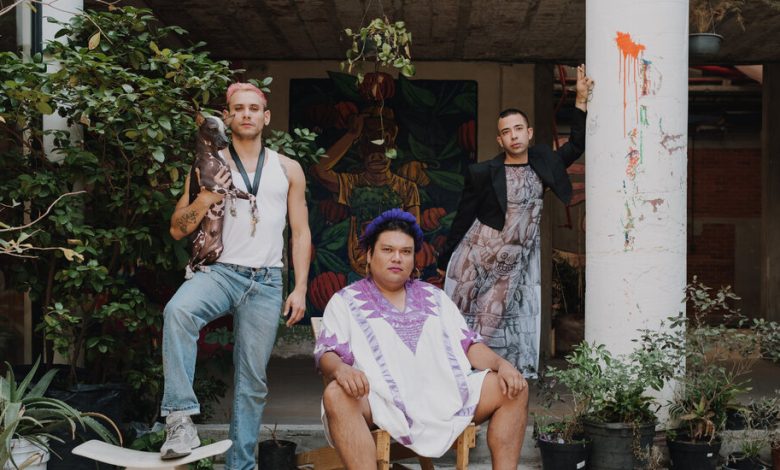In Mexico City, Club Kids Take the Stage

On the southern fringe of Mexico City’s Juarez neighborhood, a two-story apartment complex built in 1912 occupies an entire block, its elegant brick architecture contrasting with the auto parts stores across from it. On one of the historic estate’s corners, a set of white wooden doors marks the home of Alberto Bustamante, a.k.a. Mexican Jihad, 37, a co-founder of the electronic music label N.A.A.F.I. For years, his space has been a gathering place for queer artists, designers and performers who met in the capital’s 2010s party scene: N.A.A.F.I. was known for its boisterous raves in cantinas and warehouses, where a diverse crowd would dance late to techno suffused with global beats. Bustamante and his collaborators later created Traición, a monthly club night that became an inclusive haven for the city’s eclectic gender-fluid community.
Illustrators, photographers, performers and sex workers contributed their talents — by, say, designing a flier or putting on a show — and soon other creative projects flourished, some of which weren’t so late at night (after all, the N.A.A.F.I. crew was getting older). The latest idea: a pop opera, “Atlacoya: Agua Triste del Lago de Texcoco,” about how the architect Pedro Ramírez Vázquez, best known for designing the city’s Anthropology Museum in the 1960s, was used by the state to impose a patriarchal sense of nationhood. On April 29, a 40-minute piece of experimental theater (the opera’s final act) will debut at an alternative cultural center in the industrial borough of Azcapotzalco as part of Tono, a new performance art festival currently taking place across Mexico City.
“N.A.A.F.I. is critical to this city’s queer life,” says Samantha Ozer, Tono’s curator and founder. “People know them as a record label and as club fixtures, but what gets lost is how [its] members — actors, performers and artists — have long been exploring more multidisciplinary expressions.” While dozens of artist friends helped create the new piece, its core group consists of Bustamante; the playwright and artist Pepx Romero, 30; and La Bruja de Texcoco, 35, an underground trans singer who references traditional Mexican music to debunk clichés like machismo and mariachi. Here, in an edited and condensed conversation, the trio discuss the collaboration.
Alberto Bustamante (creative director): My house is always open. We’ve used it as an office, and there’s an exhibition space and a sex dungeon. Pepx and I started collaborating organically: I made the music for their plays, they came to my gigs and when we started Traición, they became its performance curator. The parties gave us a platform to explore questions of identity and our pre-Hispanic roots, always in the interest of having a good time. Our friends, who happen to be people doing interesting stuff in their fields — including the fashion designers Bárbara Sánchez-Kane and Victor Barragán and the visual artists José Eduardo Barajas and WangShui — wanted to be part of the project. The common thread of our work is to collaborate with the moment’s most relevant local talent, and we are proudly promiscuous in how our work spills over between disciplines. People inaccurately call us a collective, but the way we produce culture is more idiosyncratic. Even though we have specific backgrounds (architecture, in my case), to make an opera like this happen in Mexico, without institutional support, we have to be informal and punk. It’s similar to planning a club night.
Pepx Romero (wrote the script; plays Pedro Ramírez Vázquez): Recently, Alberto and I have been hiking a lot, sometimes aided with psychedelics. That’s how Alberto and La Bruja ended up on Monte Tlaloc while I was drafting the script: It was in a temazcal [sweat lodge] where La Bruja first embodied the opera’s pivotal character. When the two of them told me about this mountain [named after the Aztec rain god] with the continent’s highest archaeological site and an alien landscape reflective of an ancient, ritualistic worldview, I was able to use words and symbols to structure it into a story. At the end, the opera will dissolve into a party. The nocturnal celebration is our home — we aren’t turning our backs on it.
La Bruja de Texcoco (stars as Chalchiuhtlicue, the Aztec rain goddess; helped compose the score): As a musician, composer and actress, my work is centered around the many genres that exist in traditional Mexican music, which I research and use to construct my identity. Traveling around the country and meeting folk artists, I find parts of me in different places and strains of regional culture. This search led me to Texcoco [east of Mexico City], where I was told, “You’re a bruja [witch], we’ve been waiting for you.” The rest has been a journey unlike that of other trans women, as my love of music allowed me to transition hand in hand with this land’s ever-present magic. Everything I do is an offering, and the opera is an extension of it.




